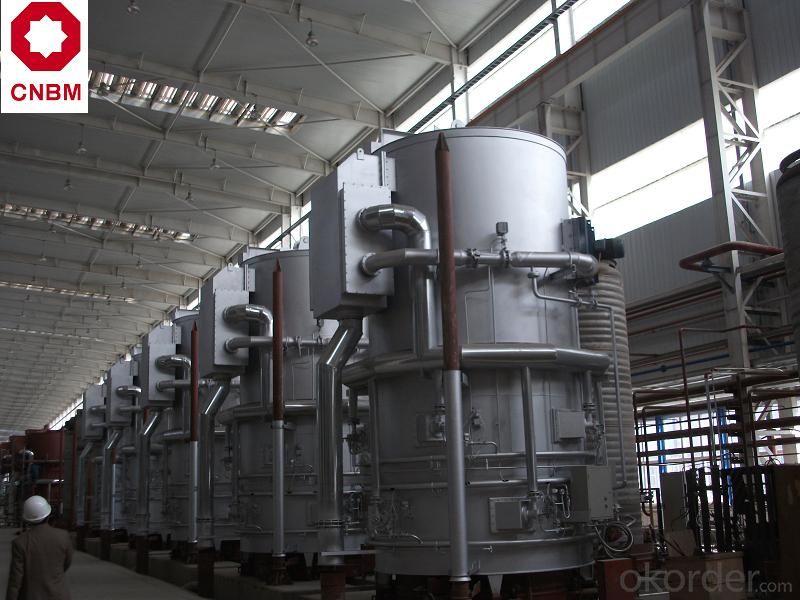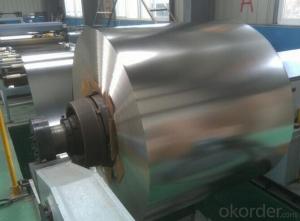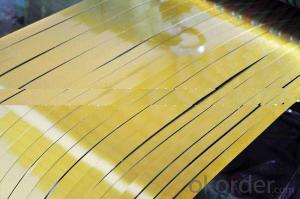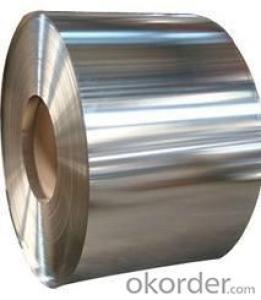MR Material Tinplate for Metal Cans Uasge, BA/CA
- Loading Port:
- Tianjin
- Payment Terms:
- TT OR LC
- Min Order Qty:
- 20 m.t.
- Supply Capability:
- 50000 m.t./month
OKorder Service Pledge
OKorder Financial Service
You Might Also Like
Item specifice
1.Usage
Tinplate is widely used for making all types of containers, containing industrial usage such as paint can, oil can, aerosol cans etc., and food cans like milk powder cans, tomato paste can, dry food cans etc.
2. Tinplate production Process
cold rolling mill---degreasing production line---tension leveler---batch annealing furnaces/continuous annealing line---tin coating line---cutting line---stock area
3. Specification
standard: GB/T2520, JIS G3303, DIN EN10202
Material: MR /SPCC
Thickness available: 0.16-0.50MM
Width available: 600~1050MM
Temper grade: T1 – DR8
Tin coating: ordinary 2.8g/2.8g, 5.6g/5.6g and others
Package: sea worthy export package.
Applications: Tin can for chemicals & paint cans, industrial cans, food cans
4.Batch Annealing Furnace

5. FAQ
a. what's the annual output?
about 400,000~500,000 tons per year.
b. what's your advantage than other supplier?
we have overseas warehouse all over the world, like Saudi Arabia, Oman, UAE, Kuwait, Russia, South Africa etc.
c. how long is the delivery time?
about 45~55 days for SPCC, while 60~70 days for MR material
d. how to control the quality during production process?
inside our workshop, we have MES syestem. It will show the status of each production step.
- Q:What is the global demand for tinplate?
- The global demand for tinplate is significant and continuously growing. Tinplate is widely used in various industries such as packaging, electronics, automotive, and construction. Its corrosion resistance, durability, and versatility make it a preferred choice for packaging materials, especially in the food and beverage sector. With the increasing population and urbanization, the demand for tinplate is expected to further rise in the coming years, driven by factors like increasing consumer goods consumption and technological advancements.
- Q:How is tinplate affected by exposure to UV light?
- Tinplate is not significantly affected by exposure to UV light since it is a highly durable material with good resistance to sunlight.
- Q:Can tinplate be used for packaging hazardous materials?
- Yes, tinplate can be used for packaging hazardous materials. Tinplate is a robust and durable material that provides excellent protection against external elements and corrosion. It is commonly used for packaging hazardous materials such as chemicals, paints, and aerosols due to its ability to withstand the potential risks associated with these substances. Additionally, tinplate is easily recyclable, making it an environmentally friendly choice for packaging hazardous materials.
- Q:Can tinplate packaging be used for chemical products?
- Yes, tinplate packaging can be used for chemical products. Tinplate is a durable and resistant material that can effectively protect chemical products from external factors such as corrosion, light, and moisture. It is commonly used in the packaging of various chemical products, including paints, solvents, and adhesives.
- Q:What are the advantages of using tinplate for automotive parts?
- Tinplate offers several advantages for automotive parts. Firstly, it provides excellent corrosion resistance, making it ideal for parts exposed to harsh environmental conditions. Additionally, tinplate offers good formability, allowing for complex shapes and designs, providing flexibility in manufacturing. It also offers high strength and durability, ensuring long-lasting performance and safety. Furthermore, tinplate is lightweight, contributing to improved fuel efficiency and reduced emissions. Lastly, it is a cost-effective material, providing value for money in automotive part production.
- Q:What are the main applications of tinplate in the pet care industry?
- Tinplate is commonly used in the pet care industry for packaging various products such as pet food, treats, and supplements. Its main applications include canning and sealing these products, ensuring their long shelf life and preserving their quality. Tinplate's ability to resist corrosion and provide a protective barrier against light, moisture, and oxygen makes it an ideal choice for pet care products that require durability and preservation. Additionally, tinplate's versatility allows for unique and appealing packaging designs, attracting pet owners and enhancing product branding.
- Q:How does the coating affect the properties of tinplate?
- The coating on tinplate plays a crucial role in enhancing its properties. It protects the underlying tin layer from corrosion, making tinplate highly resistant to rust. The coating also provides a barrier against external elements, ensuring the integrity and longevity of the tinplate. Additionally, the coating can improve the appearance of tinplate, making it more visually appealing. Overall, the coating significantly enhances the durability, corrosion resistance, and aesthetic appeal of tinplate.
- Q:Can tinplate be used for packaging electronic components?
- Yes, tinplate can be used for packaging electronic components. Tinplate is a commonly used material in the packaging industry due to its excellent strength, durability, and corrosion resistance. It provides effective protection to electronic components and helps in preserving their quality during storage and transportation.
- Q:How is tinplate coated for furniture?
- Tinplate for furniture is typically coated through a process known as electroplating, where a thin layer of tin is deposited onto the surface of the furniture. This process involves immersing the furniture in a solution containing tin ions, and then applying an electric current to facilitate the deposition of the tin onto the surface. This coating provides the furniture with a protective layer, preventing corrosion and enhancing its aesthetic appeal.
- Q:What are the quality control measures for tinplate production?
- Quality control measures for tinplate production typically include various inspections and tests at different stages of the manufacturing process. Some common quality control measures include: 1. Raw material inspection: The quality of the steel used for tinplate production is assessed, including its chemical composition, thickness, and surface finish. Any deviations from the desired specifications are flagged. 2. Coating inspection: The tin coating applied to the steel is examined for uniformity, adhesion, thickness, and absence of defects like pinholes or scratches. This ensures the protective and aesthetic qualities of the tinplate. 3. Surface inspection: The surface of the tinplate is inspected for any visible defects such as dents, scratches, or irregularities. This ensures the overall quality and appearance of the final product. 4. Dimensional control: Tinplate sheets or coils are measured to ensure they meet the specified dimensions and tolerances. This includes verifying the length, width, thickness, and flatness of the tinplate. 5. Tinplate performance testing: Selected samples are subjected to various mechanical and chemical tests to assess their performance. These tests can include assessments of corrosion resistance, adhesion, hardness, and tin coating integrity. 6. Packaging inspection: The final tinplate products are inspected for proper packaging, labeling, and protection. This ensures that the tinplate reaches customers in good condition and meets their expectations. By implementing these quality control measures, manufacturers can maintain consistent product quality, meet customer requirements, and ensure the reliability and functionality of tinplate products.
1. Manufacturer Overview |
|
|---|---|
| Location | |
| Year Established | |
| Annual Output Value | |
| Main Markets | |
| Company Certifications | |
2. Manufacturer Certificates |
|
|---|---|
| a) Certification Name | |
| Range | |
| Reference | |
| Validity Period | |
3. Manufacturer Capability |
|
|---|---|
| a)Trade Capacity | |
| Nearest Port | |
| Export Percentage | |
| No.of Employees in Trade Department | |
| Language Spoken: | |
| b)Factory Information | |
| Factory Size: | |
| No. of Production Lines | |
| Contract Manufacturing | |
| Product Price Range | |
Send your message to us
MR Material Tinplate for Metal Cans Uasge, BA/CA
- Loading Port:
- Tianjin
- Payment Terms:
- TT OR LC
- Min Order Qty:
- 20 m.t.
- Supply Capability:
- 50000 m.t./month
OKorder Service Pledge
OKorder Financial Service
Similar products
New products
Hot products
Hot Searches
Related keywords





























